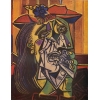|
 The life of
Pablo Picasso is the rare example of the generous fortune that allowed a great popularity
to the talented painter and an opportunity to become a founder of such a
revolutionary style in the art as cubism, yet to earn millions. As a child Pablo
painted up the legs of pigeons in the pictures of his father - the painter José
Ruiz, and he always shocked the public with the marvelous technique of
painting. The life of
Pablo Picasso is the rare example of the generous fortune that allowed a great popularity
to the talented painter and an opportunity to become a founder of such a
revolutionary style in the art as cubism, yet to earn millions. As a child Pablo
painted up the legs of pigeons in the pictures of his father - the painter José
Ruiz, and he always shocked the public with the marvelous technique of
painting.
There is the
legend that José Ruiz was astonished by the skill of his thirteen-year old son
when the latter finished the still life for him. And after that event José never
painted again. At the age of 13, Picasso managed to enter the Barcelona School
of Fine Arts, where he proved to be one of the successful students at the start
of his studies. In 1970 a
museum dedicated to the works of the great Spaniard was opened in his motherland,
in appreciation to the talented countryman from the citizens.
Picasso's
artistic life is separated by periods of very beautiful and romantic names, specifically
characterizing the emotional nature of his paintings. Thus, pictures painted between
1901 and 1904, belong to so called The Blue Period when he predominantly
painted the gloomy life of poor workers in blue and blue-and-grey cold colors.
The Rose
Period lasting from 1904 to 1906 signifies the time when the style of Pablo
Picasso's painting used cheerful orange and pink colors in contrast to the
cool, somber tones of the previous Blue Period. Harlequins, circus performers
and clowns appear frequently in the Rose Period and will populate Picasso's
paintings at various stages through the rest of his long career. The harlequin,
a comedic character usually depicted in checkered patterned clothing, became a
personal symbol for Picasso.
The first step
of the painter to the cubism, the initiator of which he was, was expressed in
his painting ‘Les Demoiselles d' Avignon' in 1907 that shocked the public with
aggression and erotic in one and incredible mass. Most opportunely, many art critics considered this
very scandal painting as the starting point of the entire modern art.
Consequently,
throughout all his artistic life Picasso develops the said style paying a
special attention to conversion of forms into geometry blocks, increasing and
breaking volumes. And though these paintings
are like puzzles to solve, it is a good luck and reputation for amateurs of
paintings to acquire them. And for those who think of the most profitable
investments into fine art works, Picasso's paintings is an excellent capital
investment.
Several
paintings by Picasso rank among the most expensive paintings in the world. Thus,
Garçon à la pipe was sold for USD 104.2 million at Sotheby's in May 2004 to an
anonymous buyer. And at New York Sotheby's in 2006 Dora Maar au Chat (1941) was
sold for USD $95.2 million. The auction facilitators did not even estimate this
painting considering that it is not possible to predict the price for such a
valuable portray. They say that the Russian billionaire, Aleksandr Abramov,
acquired the painting though the press service of the latter did not confirm
this fact.
Picasso's paintings
are the high demanded objects for thieves of artwork. Two of his paintings were
stolen at the exhibition of the museum ‘Zeddam-Kulturcentrum' located in the
Swiss town Pfeffikon near Zurich. The cost of ‘Bull's Head» and ‘Glass and jag'
goes over millions of dollars.
Picassos' paintings
are not only the pride of collectors but also the victim of their ambition. In 2006
there was an awkward situation with Picasso's ‘Le Reve'. The owner of the
picture, the largest magnate in the world of game industry, Steve Wynn, who
suffered from eye problems, accidentally pierced the canvas pointing at it with
a finger to his friends. In 1997 Steve Wynn bought the painting for USD 48,4 million.
And shortly before this incident, he decided to sell ‘Le Reve to another
collector, Steven Cowen but for USD 139 million. To the bad luck of Steve Wynn the
transaction did not happen. It might be the good sign, since the cost of the painting
after the restoration works and such a loud history might increase
unpredictably.
Picasso's pictures
are collected by reputed, famous and, surely, very rich people. Among them - Elizabeth
Taylor and Sir Andry Lloyd-Webber, well-known author of musicals «Cats» and «Jesus
Christ - Superstar» who dream to be the first musical billionaire and in
collections of the latter there are Picasso's paintings costing over USD 25
million.
Picasso has
never tired to astonish and be admired by millions of people and the secret of
his incredible popularity is unknown. It might be a supposition that every
person sees what they want to see in his pictures, the plot that is close to
every individual, and that Picasso's artworks allow interpreting them in every
possible way.
|